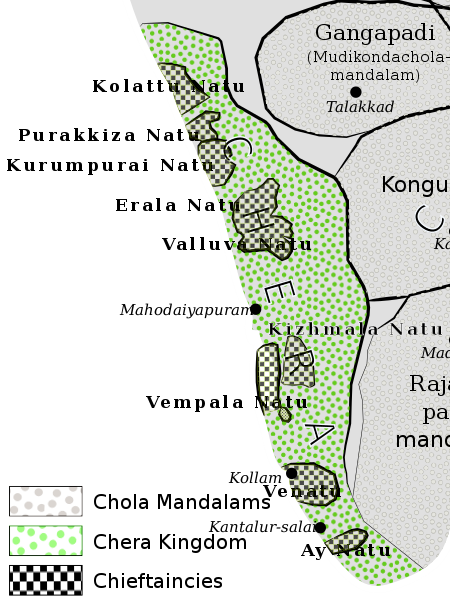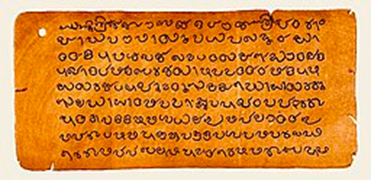

The culture of an area specifically represents a region is called the regional culture and a language is an important component of the regional culture. Now we will see how the Malayalam language represents the regional culture of the southern-Western part of India, mainly Kerala under Cheras. The rulers of this dynasty used the Malayalam language for communication and official purpose, which is evident from inscriptions of that period.
Simultaneously, Cheras followed Sanskritic tradition. In fact, the origin of Malayalam can be traced to Sanskrit as evident in literary texts of this region. One of the famous texts of the fourteenth century was Lilatilakam, which deals with grammar and poetics and was composed in Manipravalam (meaning diamonds and corals), mentioned in two languages: Sanskrit and the regional language.

Chera Kingdom
Cpt.a.haddock, CC BY-SA 4.0
There are different opinions for the development of the Malyalam language. The influence of several other Indian languages like Prakrit, Pali, Marathi, Hindi, in fact some foreign languages like Persian, Dutch and French can be observed in its evolution. Therefore, it is interesting to know that many languages have affected the Malayalam in the past.
The Cheras were believed to be Kerala kings but people also confused them as Tamils as they wrote some literature in Tamil. Following are some beliefs about the background of Cheras −
Cheras initially spoke Tamil and the entire Kerala was ruled by Tamils.
The Chera Prince Elangoadigal was a great Tamil writer.
Malayalam is the newly developed language in the subcontinent of India. It developed from Tamil only after the Seventh century BCE.
From the tenth to the fourteenth century mainly Tamil script was used in Malayalam.
Malayalam is somehow ancient Tamil along with Sanskrit touch.

Royal Charter (plate I, side I) issued by the Chera/Perumal king of Kerala, South India to Joseph Rabban, a Jewish Merchant Magnate
Ms Sarah Welch, CC BY-SA 4.0
The south-western peninsula saw the rise of a strong kingdom called the Cheras of Mahodayapuram in the ninth century, now known as Kerala.
Initially the rulers of this kingdom used to speak Tamil. Gradually they adopted Malayalam (a combination of ancient Tamil and Sanskrit).
Now these rulers started using Malayalam as a medium of communication and issuing royal proclamations and inscriptions, which means it became the official language of that region.
The Malayalam language flourished under the Chera rulers. Although it was already spoken in the area in the ninth century when Cheras rose to power in the southern peninsula. These rulers began to inscribe their inscriptions and started using Malayalam for administrative purposes. This is how the language began to gain importance and became the official language of Cheras. And it became an important part of Chera's literature. And from there onwards, Malayalam became the regional language of the area.
The language originated from Sanskrit traditions mainly the temple theatre of Kerala, like Sanskrit epics and stores. In a nutshell, the Malayalam language in Kerala owes its development to the adoption of the Sanskrit culture under Cheras. In this way, Cheras developed Malayalam and Sanskrit altogether.
Malayalam had been a local dialect initially. The word ‘Malayalam’, refers to the land in the middle of the Western Ghats and the Arabian sea. In this word ‘Mala’ denotes an elevated land, and the ‘Alam’ refers to the abyss of the ocean .
Malayalam belongs to the Dravidian language. Which is part of the south Dravidian branch. This is commonly spoken in Kerala and the union territory of India i.e., Lakshadweep. It is spoken by some people in Karnataka and Tamil Nadu.
It is believed that Malayalam comprises three insignificant regional dialects and numerous other small ones. Subsequently, the Malayalam language has evolved as a diglossia, in which a clear distinction was made between the literary language and the conversational language of the society.
There is one more belief about Malayalam that it developed either from a western dialect of Tamil or belongs to the same Primitive-Dravidian group of the language.
The initial evidence of this language, like an inscription dated back to 830 CE, suggests the considerable influence of Sanskrit on the Malayalam. It is believed that words in Koleluttu or “Rod Script”, had been taken from the Grantha script, which is part of Brahmi script. In fact, the Koleluttu has letters, which represent the collection of phonics from both Dravidian and Sanskrit.
One of the earliest literary works in Malayalam was Ramacharitam, an epic poem written by the end of the 12th century. Eventually, along with a popular pattu i.e.,“song” in literature, there emerged a kind of literature which mainly comprised famous poetry made in the manipravalam (“ruby coral”) style, a combination of the Malayalam and the Sanskrit.
The Cheras’ rise into power in Kerala and parts of Tamil Nadu marked the development of the Malayalam language in the region. The language was initially adopted as a means of communication but gradually it became an official language too. There is evidence which portrays that this language had a touch of Sanskrit. In fact it is also opined that Malayalam is not a new language rather it is an ancient Tamil with the influence of the Sanskrit traditions.
As far as the origin of the Malayalam language is concerned, there are different schools of thought. Some scholars opine that it had originated from ancient Prakrit. Another group of scholars believe that it was a local language of forest tribes which got combined with the Dravidian family and transitioned in due course of time to become Malayalam. Some scholars even denied any similarities between Malayalam and Tamil as they argued many themes remained so distinct in these two languages. On the one hand, some even argue that Tamil is the mother of Malayalam. On the other hand, some scholars professed that Malayalam and Tamil belong to Dravidian families and these two are sisters.
Q1. Who were Cheras?
Ans. The Cheras were one of the powerful kingdoms ruled over the southern part of India in the ancient period of Sangam Age. They started controlling some parts of central and northern Kerala along with the Kongu region of Tamil Nadu.
Q2. What do you understand by dialect?
Ans. The dialect refers to the specific form or type of the language spoken in a particular region or a community of people.
Q3. Name some Malayalam literary works.
Ans.
Almarattam by Kalloor Umman Philipose.
Kamakshee Charitham by K. Chidambara Wadhyar.
Varshakala Katha by K. Chidambara Wadhyar.
Q4. Who was the founder of the Chera dynasty?
Ans. Uthiyan Cheralathan had founded the Chera dynasty. The dynasty was believed to belong to one of the two clans namely; Irumporai and Vanavarmana.
Q5. Mention other languages of the Dravidian family of language.
Ans. Kannada, Telugu, Tamil along with Malayalam are members of the Dravidian family of language.
Q6. Who were the contemporaries of the Chera Kingdom?
Ans. The contemporaries of the Cheras were Pandyas and Cholas in the southern part of India. These three were powerful kingdoms of South India. Later Cheras and Pandyas allied together in order to defeat the Cholas.